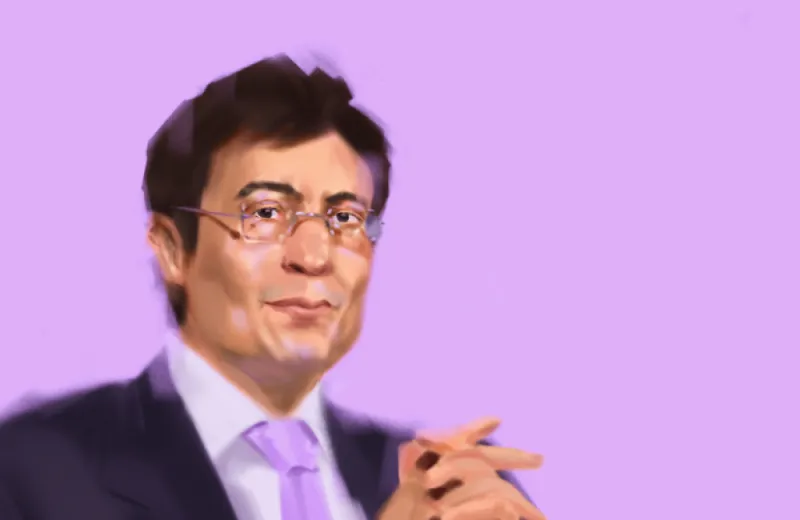
Illustration by II
When British hedge fund manager Christopher Hohn launched The Children’s Investment Fund Management in 2003 — pledging to donate 50 basis points of the management fee to a charitable fund — even he wasn’t so sure it was a good idea.
“No one did that before,” recalls Ana Marshall, chief investment officer for the William and Flora Hewlett Foundation’s $14 billion portfolio and one of Hohn’s initial investors. “From the beginning, Chris created a fee structure that was intentional about philanthropy.”
The philanthropy in question was the Children’s Investment Fund Foundation, a charitable fund founded by Hohn and his then-wife Jamie Cooper-Hohn, who ran the charity. But even though Hohn knew he wanted to be philanthropic, at the time he wanted to do it privately.
“I was onboard with giving money away but not convinced I should be public about it,” he conceded during a recent 90-minute phone interview. “I thought it would be a deterrent to investors. Some investors said they don’t mind if you get very rich, have fast cars and prostitutes,” Hohn explained, as long as you don’t give to charity.
His American-born wife, whom he met at Harvard, was the one who convinced him to be public about the philanthropy. “She was against starting a fund just to make money for myself,” he says. “She said if you [did the philanthropic pledge] publicly, it would encourage other people.”
As it turns out, the charitable policy became Hohn’s defining distinction in a very crowded hedge fund industry that for decades had lured a steady stream of new entrants fantasizing about becoming the next hotshot hedge fund billionaire.
In fact, Hohn was knighted for his philanthropy in 2014. More recently, he took the Giving Pledge to give a majority of his wealth to charity.
Although TCI Fund Management, as it is known, stopped contractually making donations to the foundation after the 2008–’09 financial crisis, it has endowed the charity with a total of $2 billion.
Hohn is currently the chairman of the foundation, which aims to improve the lives of children in poverty in developing countries. Over the years, it has given away $3 billion.
Meanwhile, TCI, which today manages $42 billion and an additional $6.9 billion in a real estate business, has generated $36.5 billion in profits for its investors, including $9.5 billion in 2021, according to LCH Investments, which makes this calculation every year.
And despite a devastating 43 percent drawdown in 2008 amid the global financial crisis, TCI has generated an 18 percent annualized gain since its inception, exactly double the return of the S&P 500 index and more than double the MSCI World Total Return during the same time period.
“Chris never lost sight that he is working for his LPs,” says Tom Hill, chairman of Two Sigma Investment’s private investment business and former head of Blackstone Alternative Asset Management, where he was an early investor in TCI. He is quick to point out that Hohn has his own considerable net worth invested in the fund.
Hohn has generated his impressive performance numbers running a mostly long-only, very concentrated global portfolio of stocks.
In the early days, he emphasized what he calls special situations, investing in a wide array of industries that included manufacturers, consumer products companies, and even banks. But since the financial crisis, Hohn has focused on monopoly assets with strong pricing power and high barriers to entry. These include companies such as Microsoft, Alphabet, Visa, and the ratings agencies.
Although he is often described as an activist investor, Hohn did not initially plan to take part in that kind of engagement. But it quickly became part of his repertoire — and these days, he describes activism as a tool to protect his investments.
One recent example is TCI’s “Say on Climate” initiative, launched in 2020. Supported by CIFF, the campaign urges companies to disclose their emissions, present an action plan to reduce those emissions, and seek nonbinding shareholder approval on an annual basis.
The initiative has been voluntarily adopted by about two dozen companies and nearly 20 asset management firms.
For his investing accomplishments as well as his extensive philanthropic and socially conscious contributions, Hohn is this year’s recipient of Institutional Investor’s Hedge Fund Lifetime Achievement Award.
Says Hill, “Chris is way ahead of everyone else in terms of social justice, giving credence to how lucky we all are.”
The fitness-conscious vegan — Hohn gave up meat more than 20 years ago — says he initially wanted to be a doctor, but abandoned those plans when he realized he was squeamish at the sight of blood. “It was a bad career choice,” he quips.
Because his family “was poor” — his words — Hohn figured that if he wasn’t going to be a doctor, he should be in business in some shape or form. It was while working toward his BSc in accounting and economics at Southampton University that he was set on the path to becoming a hedge fund manager.
One of his instructors, Maurice Pinto, a Harvard MBA who had been a co-founder of Sea Containers, took a liking to Hohn and suggested he attend Harvard Business School. “I never thought about it,” Hohn says. “Without his reference and encouragement, I never would have gotten in. It was a big break for me, and a very important step for me in my journey.”
When Hohn graduated from Harvard in 1993 with an MBA, he was a Baker Scholar, meaning he ranked among the top 5 percent of his class. He then worked for a short time at a consulting firm before moving back to London in 1994 to be an analyst at private equity firm Apax Partners.
Two years later, Hohn left Apax and returned to the U.S. to marry Cooper and look for a job. He recalls visiting Seth Klarman at Baupost Group, offering to work for free to gain experience even though he had no money.
Klarman turned him down. “He thought I wouldn’t stay,” Hohn recalls. “No one stays forever.” (The Baupost CEO declined to comment on the encounter.)
Klarman, however, referred Hohn to friend Richard Perry’s hedge fund, Perry Partners. “He was impressed that I graduated in the top 5 percent as a Baker Scholar, and Seth recommended me,” Hohn says.
Perry told Hohn that he’d like to offer him a job but had no desk, the TCI founder recalls. Hohn replied that he could bring his own.
Hohn got the job and stayed with the firm for seven years. In 1998, he moved to London to open Perry’s U.K. office. He would launch Perry Capital European Fund in the spring of 2000. At the time, Hohn says, Europe was a hot market, with a lot of privatizations and restructurings — and a lot of cheap stocks. “It was ripe for special situations,” he explains. “It was like a candy store of fantastic opportunities.” These included an Italian toll road and French insurance privatizations.
The Perry Capital European Fund grew to more than $1 billion in three years. During that period, Hohn generated a better than 20 percent annualized return.
In 2003, Hohn decided to leave to start TCI Fund Management. He had never fully adopted the event-driven, merger arbitrage style and was frustrated with Perry’s insistence on running portfolios with relatively low net market exposure. (Hohn preferred to run a more concentrated, mostly long portfolio.)
When launching TCI, Hohn told prospective clients he would donate a third of the 1.5 percent management fee to CIFF.
After its first month, January 2004, the fund was already managing about $470 million.
“I thought he was a really talented investor,” Marshall recalls. “You could tell he did his own deep research and truly believed the story. He didn’t leave details to the team. I came from the money management side. I can tell who is BS’ing. He clearly knew his stuff and could understand the thesis.”
As for Hill, he remembers being impressed by Hohn’s business plan and historical track record. “In the hedge fund business they can have fancy bells and whistles, but ultimately you have to trust they do what they say they are going to do, that they have strong risk management protocols in place and are not going to take foolish bets, engage in style drift, or chase capital to grow AUM just to earn more management fees,” he says.
Hohn is in fact well known for carrying around what he calls a “quality list” of target companies, including each company’s enterprise value, leverage, and margins; what he would pay for it; and the potential IRR over three to five years, among other information. These days, the list is on a spreadsheet on Hohn’s computer.
Hohn started off doing mostly special situations investments in Europe. On day one, he put 20 percent of his capital into two Korean companies — including consumer electronics maker LG Corp., whose stock went up five times.
“I always decided to be concentrated,” he says.
One of his early themes was publicly traded stock exchanges. Hohn took large stakes in Deutsche Börse and Euronext. When the two exchanges tried to merge soon after, he stepped in and played a major role in preventing the deal from being completed — his first foray into activism.
Euronext wound up being acquired by the New York Stock Exchange the following year.
In 2007, Hohn bought 1 percent of the shares of Dutch banking giant ABN Amro, which represented 10 to 15 percent of his hedge fund’s capital. He filed a resolution at the company’s annual meeting urging it to put itself up for sale. Shareholders then forced the company to put itself up for auction. A consortium of three banks — Royal Bank of Scotland, Fortis, and Banco Santander — ended up paying roughly $100 billion in all cash at the peak of the market.
By May 2008, Hohn had racked up annualized gains of roughly 40 percent in each of his first four years and built the firm to $19 billion in assets, with a staff that included 12 analysts.
Then came TCI’s first major test.
But in 2009, as the market recovered and the S&P 500 surged 26 percent, TCI was up only 10 percent. Hohn attributes the underperformance to the fund’s all but shutting down risk. He followed that disappointing year with gains of just 9 percent and 7 percent in 2010 and 2011, respectively.
Many of Hohn’s investors, unhappy with the fund’s mediocre results after the huge drawdown — not to mention its unusually severe three- and five-year lockups — began fleeing en masse as their terms expired.
By the end of 2012, assets had shrunk to $4.9 billion in the main fund, even after it posted an impressive 29.5 percent gain that year — its best performance in five years.
Investors weren’t the only ones eager to escape the firm: From 2009 to 2011, several analysts and the head of investor relations also left.
This period was a big wakeup call for Hohn.
In a 2015 interview with Institutional Investor, Hohn looked back at the 2008 debacle and the ensuing mediocre years and conceded, “We had strayed from being heavily invested in stocks, with a high barrier to entry and a bulletproof franchise to weaker industries. Then we weren’t fully invested in 2009. The team and the fund got too large.”
To get back on track, Hohn moved away from special situations, jettisoning stocks in industries like banks and commodity companies and pivoting away from what he deemed to be weak businesses, such as manufacturers.
Instead he focused his very concentrated portfolio on monopoly companies with large moats or high barriers to entry and very strong pricing power, he says in the recent interview.
“We found it in many different places,” Hohn notes.
These targets have included media content companies like Newscorp, which TCI has invested in twice over the past decade.
The first time was during Newscorp’s hacking scandal in 2011. The second was four years ago, when TCI took an outsized stake in 21st Century Fox — Newscorp’s new name — when the media giant put itself up for sale. It wound up selling many of its assets to Walt Disney, which was vying with Comcast at the time.
“I visited [chairman] Rupert [Murdoch] during the Disney-Comcast fight, and I demanded the company sell to the highest bidder,” Hohn recalls. “He said, ‘I would like the same thing, but I can’t say it. I’m under contract.’”
At the end of 2021, TCI held just 13 different stocks in its $44.4 billion U.S.-listed stock portfolio; its five largest holdings accounted for two-thirds of the assets. And all of them are the kind of dominant companies that Hohn prefers.
They included Google parent Alphabet; broadband giant Charter Communications, which TCI has held since 2016; cloud computing giant Microsoft, which it initiated in 2017; credit card payments giant Visa; and Canadian National Railway.
The tighter focus has clearly paid off. Over the past ten years, TCI has generated a better than 19 percent annualized return, posting double-digit returns in eight of those years. It has never lost money since the huge 2008 drawdown.
In early 2019, TCI made the unusual offer to return some capital “to provide investors additional flexibility to manage the size of their [investment] in TCI through a modest rebalancing opportunity,” according to a client letter at the time.
Unsurprisingly, few investors took advantage.
This said, Hohn was recently locked in a battle with Canadian National Railway. In May 2021, TCI doubled its stake, to 8 percent, when the railroad giant announced a bidding war for Kansas City Southern. (TCI also has a big stake in Canadian Pacific Railway.)
TCI fired off a letter to CN chairman Robert Pace opposing the merger, asserting, in part, that the company was taking a big risk by committing roughly $2 billion related to potential breakup fees as it awaited regulatory approval.
The firm also complained about “weak leadership” that “resulted in deteriorating financial and operating performance,” calling for CN to replace chief executive officer Jean-Jacques Ruest with Jim Vena — who had served as chief operating officer from February 2013 to July 2016.
And TCI nominated four directors to the board.
In September, Kansas City Southern terminated the merger agreement with CN and agreed to merge with Canadian Pacific. The same month, Canadian National announced a plan to cut spending and improve profitability and pledged to repurchase $4 billion in stock.
In October, CN agreed with TCI to hold a special shareholder meeting on March 22, 2022. Two weeks later, CN announced the retirement of its president and chief executive officer, effective January 2022.
Then in January, CN and TCI reached an agreement whereby the railroad would make several changes to its board, including committing to appointing two new independent directors.
Hohn stresses that in general TCI does not plan to be so aggressive as an activist. But one area where it is becoming much more active is in its campaign to address climate change.
The firm’s Say on Climate initiative has been voluntarily adopted by nearly two dozen companies, including Royal Dutch Shell, Unilever, and Moody’s, as well as 19 asset managers, including Soros Fund Management and Caxton Associates.
Altogether, more than 100 investors support Say on Climate if you count the 54 investor members of the Institutional Investor Group on Climate Change and the major French investors via Forum pour l’Investissement, which have issued public statements of support.
TCI requires all of the companies in its portfolio to have a climate plan and put it up to shareholders.
According to TCI, key principles of a credible climate action plan include a pledge to reduce emissions by 50 percent by 2030 and the belief that a long-term target (beyond ten years) without a short-term plan (five years) is inadequate.
Climate change has been an important issue for Hohn for many years. His foundation, CIFF, has been active in environmental causes for more than 15 years, with an arm dedicated to climate change.
Hohn points out that addressing climate change is related to the foundation’s initial focus on children in poverty, especially in Africa and India. As soil dries out because of drought, it is harder to grow food, which will increasingly cause malnutrition, he explains.
Of the $500 million CIFF plans to give out this year, $200 million is aimed at climate change, Hohn says.
Hohn also co-founded the European Climate Foundation, which he says today spends $100 million a year on advocacy and technical assistance to support Europe’s pledge to cut emissions by 2030.
One goal is to end what he calls “dirty finance,” which means financing fossil fuels and high emissions. Hohn says 35 percent of emissions are created in the corporate sector. “Instead of cutting emissions in half, corporate emissions are rising,” he notes.
Hohn’s climate change efforts got a big boost in late March from U.S. regulators when the Securities and Exchange Commission proposed rule changes that would require companies to include certain climate-related disclosures in their registration statements and quarterly and annual reports. These would include information about climate-related risks that are “reasonably likely to have a material impact” on their business, results of operations, or financial condition, and certain climate-related financial statement metrics in a note to their audited financial statements. The required climate-related risk assessments would include disclosure of greenhouse gas emissions, “which have become a commonly used metric to assess a registrant’s exposure to such risks,” according to the announcement.
“That was an important moment,” Hohn says.
For Hohn, the climate change and other philanthropic efforts are what differentiate TCI. “We set out from day one to create philanthropic funds,” he says.
The sentiment is lauded by Joe Dowling, the global head of BAAM, who has known Hohn since they met at Harvard Business School in 1991.
“It goes back to his core DNA to impact the world,” Dowling says. “He wants it to be a better place.”
In fact, the first time Hohn received a significant bonus at Perry Capital, he gave it to charity.
As for the $2 billion that he has gifted to his foundation over the years, it has doubled several times over, creating $7 billion in capital gains.
“I always felt I was a custodian; the money is never really mine,” says Hohn, who nonetheless made more than $2 billion last year, thanks in large part to his compounding wealth in his fund. “What’s the point of making lots of money if not having the joy of giving of service, meaning, and purpose? I still stick to the original goal: Do well for investors and encourage philanthropy through example.”





